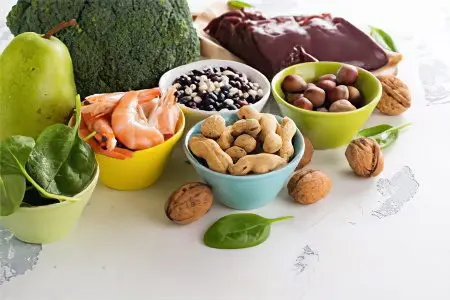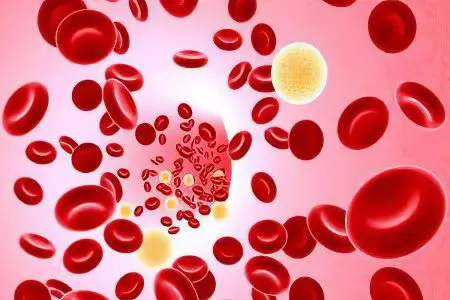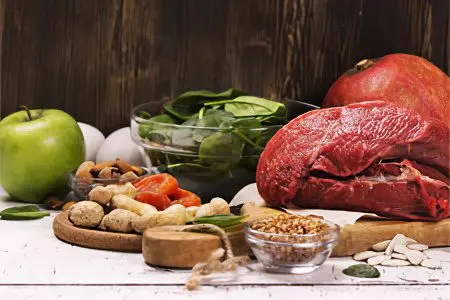Contents
- What is anemia and why does a person need hemoglobin?
- Why does anemia develop and how does it manifest itself?
- What foods to eat with anemia?
- Medical recommendations
- Anemia and diabetes
- Nutrition for anemia: recipes
- What can not be eaten with anemia?
- How to increase the absorption of iron?
- Menu for the week for people with anemia

Anemia is a common disorder that is found in every 7 inhabitants of Russia. At the same time, many people do not even suspect that the level of hemoglobin and red blood cells in their blood is reduced. Anemia often manifests itself with symptoms such as increased fatigue and fatigue. A modern person, living in an active rhythm, attributes his condition to the abundance of problems that he has to solve at home and at work.
In fact, distinguishing the symptoms of anemia from banal fatigue is not always easy. Moreover, anemia often acts as a background condition of a particular pathology.
With anemia in the blood, there is a decrease in the level of erythrocytes and hemoglobin, hypoxia of organs and tissues develops. A common cause of all these troubles is malnutrition, when a person abuses fast food, depriving his menu of fresh and healthy products.
What is anemia and why does a person need hemoglobin?

There are several types of anemia:
Deficiency anemia, which is characterized by a lack of vitamins and nutrients in the body. Moreover, most often a person suffers from an iron deficiency. The process of hematopoiesis is disturbed, anemia develops.
Hemolytic anemia, characterized by the death of red blood cells. The reasons for starting this pathological process can be very diverse, ranging from poisoning with toxic substances to genetic mutations.
Sickle cell anemia, which develops due to the mutation of red blood cells. As a result, their shape changes, erythrocytes become unable to perform their functions. This anemia is inherited.
Aplastic and hypoplastic anemia. These are severe pathologies that develop due to bone marrow failure.
Acute or chronic posthemorrhagic anemia. This anemia develops against the background of bleeding.
It is iron deficiency anemia that occurs in medical practice more often than other pathological conditions. To determine this violation, you will need to perform a clinical blood test.
Hemoglobin is a protein that contains iron. It is responsible for supplying oxygen to all internal organs. When the level of hemoglobin falls, the cells of the body begin to experience oxygen starvation, which affects the functioning of all organs and systems.
Normally, the hemoglobin level for women should remain at around 120-140 g / l, and for men at around 130-160 g / l.
As for children, normal hemoglobin values vary depending on their age:
Immediately after birth, the hemoglobin level will normally remain at around 145-225 g / l.
When the child reaches the age of 3 months and up to six months, hemoglobin values u95bu135bwill be equal to XNUMX-XNUMX g / l.
After a year and up to 18 years, the level of hemoglobin gradually increases and is equal to that of an adult.
For pregnant women, the values of the hemoglobin norm rise to 110-140 g / l. This jump is due to the fact that the fetus is growing. For his needs, the reserves of iron and folic acid from the depot of the body of the expectant mother are spent.
Why does anemia develop and how does it manifest itself?

There are various reasons that lead to the development of anemia, among them:
Bleeding, which can be the result of previous operations, or develop against the background of injury. Menstruation, which differs in duration and abundant discharge, leads to blood loss in the female body. Inflamed hemorrhoids can lead to the development of bleeding, and ulcerative lesions of the stomach and intestines are also the cause of chronic blood loss.
Diseases of a neurological nature and mental disorders can become an impetus for the manifestation of anemia, since immunity decreases against their background.
Physical inactivity, as well as enhanced training, can lead to the formation of anemia.
Pathologies of the urinary system, gastrointestinal tract can become the basis for the formation of anemia.
Worm infestations lead to the fact that parasites take on some of the nutrients, impoverishing the human diet.
Past infections and cancerous tumors pose a serious threat to human health and life. Very often these diseases are accompanied by anemia.
Errors in nutrition, in particular, insufficient consumption of animal products, cause anemia.
When exposed to the human body of one or more causes, it develops anemia.
This condition is characterized by the following symptoms:
Depressed mood.
Excessive fatigue.
Noise in ears.
Unexplained muscle weakness.
Daytime sleepiness.
Dizziness that occurs with a certain frequency.
Dryness of the mucous membranes of the oral cavity.
Paleness of the skin, poor condition of the hair and nails.
carious teeth.
An increase in body temperature to subfebrile marks.
What foods to eat with anemia?
Food for anemia should be rich in iron. Therefore, it is recommended to enrich your diet with the following products: meat and fish, cream and butter, liver, tongue and kidneys of animals.
Plant foods can also become a source of iron, but it will not be absorbed in such volumes as from animal products. Nevertheless, it is useful to eat cereals (legumes and buckwheat), vegetables (tomatoes, beets, potatoes, bell peppers, carrots), fruits (pears, apples, plums, pomegranates, apricots, quinces, persimmons), berries (currants, strawberries, strawberries, blueberries), and mushrooms.
The source of iron for the body is not only food, but also drinks: juice of plums, apples, grapes, tomatoes, beets and carrots. It is also useful to drink tea with honey and lemon.
The products needed to replenish iron stores in the body are presented in the table:
Products | Iron content in 100 g in mg |
beans | 72 |
hazelnuts | 51 |
Hercules | 45 |
low fat cheese | 37 |
Buckwheat grain | 31 |
Pork liver | 29,7 |
Peas | 20 |
Brewer’s yeast | 19 |
sea cabbage | 16 |
dried apples | 15 |
Dried | 12 |
Blueberries | 9 |
beef liver | 9 |
Heart | 6,3 |
Beef tongue | 5 |
Medical recommendations
Find out what you can eat with anemia from your doctor. However, proper nutrition alone is not enough to get rid of anemia, you will need to take medications. However, diet plays a huge role. Products entering the body should be rich not only in iron, but also in other useful substances, vitamins and trace elements.
About 20 mg of iron should enter the human body per day. It will be absorbed better if you combine it with vitamin C. For example, it is useful to eat buckwheat porridge and drink it with pomegranate juice, or meat with plum juice.
Anemia in a child: how to raise hemoglobin?
Anemia is a dangerous disorder in childhood, so it must be dealt with correctly. So, oxygen starvation of the internal organs of the child will lead to a delay in his development, both mental and physical. The kid becomes whiny, aggressive, lethargic.
If you find these symptoms, you should contact your pediatrician and take a blood test. Often it is anemia that causes these symptoms. If a nursing mother leads a proper lifestyle and eats healthy food, then under the age of six months, anemia in children does not often develop. After all, iron from breast milk is absorbed by the body of the crumbs very well. Therefore, if anemia develops in a child who is breastfed, then the mother’s diet should be changed. When introducing complementary foods, you should follow the basic rules, making the child’s menu healthy and varied. On the table should be present products such as: beets, meat, apples, buckwheat, juices (apple and pomegranate).
When the child grows up, the problem of anemia will be solved by itself, but only on condition that the baby eats properly. By the age of 3, the diet of a preschooler expands significantly. It includes a wide variety of products that do not cause allergies.
Anemia during pregnancy and lactation: how to raise hemoglobin?

A woman carrying a fetus should eat right. This will cover the needs of not only her body, but also the needs of the child growing in her. Iron deficiency will lead to the development of anemia in both the pregnant woman herself and the child. This is very dangerous, as it causes a delay in intrauterine growth and development.
Therefore, the expectant mother should adhere to the following recommendations:
You need to drink green tea, it allows iron to be better absorbed. It is best to avoid the consumption of black tea.
Pomegranate juice should be consumed in small volumes, as an excess of it can provoke stool retention.
Products containing iron will help maintain a normal level of hemoglobin in the blood of the most pregnant woman and child.
If you have frequent diarrhea or vomiting, you should consult your doctor. This problem cannot be ignored.
Anemia and diabetes
Diabetes mellitus leads to a malfunction in the functioning of the kidneys, which are responsible for the production of a hormone called erythropoietin. It is needed by the red bone marrow to produce red blood cells. Diabetes provokes the death of cells responsible for the production of erythropoietin, which leads to the development of renal failure and anemia.
It is possible to get rid of anemia that develops against the background of diabetes mellitus only with the help of drugs that contain erythropoietin in their composition. However, this does not negate the observance of the principles of proper nutrition.
The diet of such patients should be strict, enriched with iron and folic acid. Therefore, the menu should include pomegranates, persimmons, legumes, vegetables, buckwheat, juices.
Nutrition for anemia: recipes

To increase the level of hemoglobin in the blood, you need to use the following recipes:
Vitamin blend. To prepare it, you will need 0,5 kg of prunes, walnuts, raisins and dried apricots. All these products are passed through a meat grinder and mixed with honey (0,35 kg). The mixture is stored in the refrigerator under a closed lid in a glass jar. You need to take it 2 tablespoons before meals, 3 times a day.
Juice with beets and carrots. Mix 50 g of beetroot juice, 100 g of carrot juice and a tablespoon of honey. All components must be combined and drunk before dinner.
Cranberry-apple juice. To prepare the drink, you need to mix half a glass of cranberry and apple juice, add a tablespoon of beetroot juice. Drink this drink 4-5 times a week.
Delicious flour to increase hemoglobin. Walnuts and buckwheat groats are ground into powder on a coffee grinder (a glass each). Add 100 g of honey to the powder mixture. Take the medicine inside a tablespoon 3 times a day a few minutes before meals.
Vitamin cocktail. To prepare it, you will need to mix the juice of pomegranate, carrots, apples, beets and grapes. To sweeten the drink, you can add honey to it.
What can not be eaten with anemia?

There are foods that help reduce the absorption of iron in the body. Therefore, they should be excluded from the menu.
They include:
All fatty foods.
Sweets and flour products.
Tea and coffee.
Gas drinks.
Canned foods.
Vinegar.
Alcoholic drinks. If a person drinks a surrogate, then with anemia it can be deadly.
Foods containing a lot of calcium.
How to increase the absorption of iron?

In order for iron to be better absorbed by the body, you must use the following recommendations:
Meat and liver should be eaten with vegetables, beets and carrots are especially useful.
Ascorbic acid helps iron to be better absorbed, so it is useful to drink cereals, fish and meat dishes with orange juice.
Eating 50-70 g of honey per day will allow iron to be better absorbed in the body. Honey is also good for boosting immunity.
Experts recommend that patients with anemia eat pears, which increase the concentration of hemoglobin in the blood.
It is enough to follow these simple recommendations so that anemia recedes, or does not appear at all.
Menu for the week for people with anemia
Breakfast | Dinner | Dinner |
Boiled buckwheat. Tomato juice | Stewed vegetables, boiled meat, pomegranate juice | Salad with fresh vegetables, fresh berries |
Steamed fish | Beans with meat, juice with carrots and beets | Buckwheat and beef liver, fresh pomegranate |
Hercules with berries green tea | Vegetable soup, chicken breast, carrot juice | Baked fish, rice, juice with grapes and apples |
Pomegranate juice and muesli | Meat and pea soup, tomato juice | Buckwheat with liver, vegetable juice |
Berries and cottage cheese, freshly squeezed juice | Soup with hearts, green tea | Potatoes and meat, tomato juice |
Buckwheat with raisins, orange juice | Beef liver, stewed vegetables, carrot juice | Stew, vegetable salad, mashed potatoes |
Muesli and green tea | Vegetable stew, meat and pomegranate juice | Rice, fish, vegetable salad, grape and apple juice |
Food that allows you to increase the level of hemoglobin in the blood can be not only useful, but also varied, without compromising the taste of dishes. Thus, following the advice of specialists, you can prevent the development of anemia.









